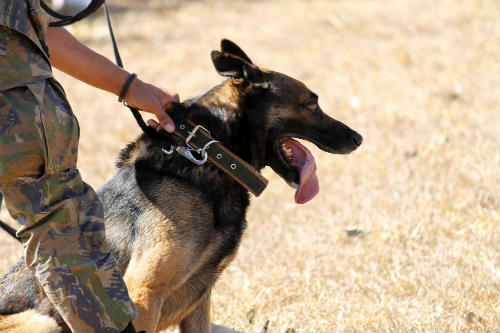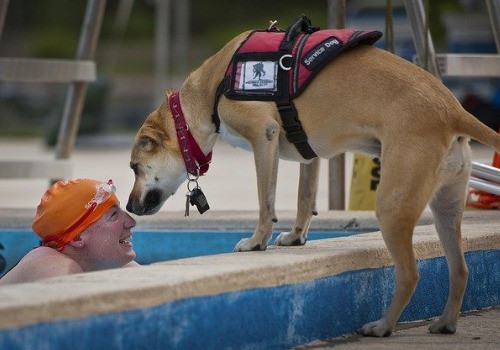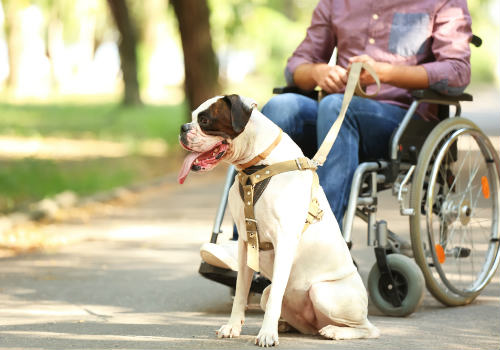Dogs are incredible companions whether they’re helping you out on the job or just relaxing with you at the end of the day. They’re loyal, social, and highly intelligent – the perfect combination of traits for a pet to have. But some dogs put their skills into even greater action, helping people with disabilities make their way through the world.
Service dogs are invaluable additions to many people’s lives. They’re given rigorous training in order to detect and assist with a huge variety of medical issues. Whether they’re leading the visually impaired through dense crowds, fetching medication during a panic attack, or helping their owners up after a fall, service dogs perform amazing life-saving feats every day.
Many people don’t realize just how common service dogs are. In fact, even celebrities have service dogs – comedian Drew Lynch, actress Carrie Fisher,

Celebrity Canines: Famous People and Their Service Dogs
Drew Lynch
When Drew Lynch was just 23, he was struck by a softball that left him with a concussion and an injured throat. The incident resulted in a permanent stutter: a speech impediment that could easily have crushed his dream of becoming an actor. But Lynch was able to make the best of the situation; keeping his spirits high, he decided to pursue stand-up comedy.
Lynch’s self-deprecating charm and sense of humor about his disability won him glowing praise from the judges of America’s Got Talent. He appeared as a contestant on the show’s 10th season in 2015, progressing all the way to the season finale, where he won second place. Since then his career has continued to take off; he’s acted in various roles on various TV shows, taken his stand-up comedy on tour around the country and launched a wildly successful YouTube channel.
Lynch attributes much of his success to his commitment to finding positivity in negative events, and one of these positive things is his service dog, Stella. She is a Hungarian vizsla who assists Lynch when he experiences anxiety and panic related to his severe stutter. Stella can sense when Lynch begins to feel uncomfortable or anxious and helps him exit overwhelming situations.
Stella and Lynch have such a deep bond that much of his comedy references her. He posts weekly “Dog Vlog” videos on YouTube that feature Stella as a character. The videos are both funny and educational, with Lynch using his platform to teach his viewers about service dogs, dispel misinformation about them and offer a glimpse into life with a service dog.
Drew Lynch is a stand-up comedian who became well-known after appearing on America’s Got Talent in season 10. His service dog, Stella, provides emotional and physical support. She is also a regular feature in his “dog vlog” videos on YouTube, where she can be seen sitting calmly beside her owner while amusing and often sarcastic comments appear in text over her head.
Lynch has a severe stutter, and Stella helps him with the day-to-day emotional toll of his disability.
Drew Lynch has such a following that there’s even a song available on Amazon dubbed Do the Drew Lynch by Blindsight. A very cool song and worth a listen!
According to The Stuttering Foundation, a service dog can be a tremendous help to people with disability. People who stutter often take a long time to say what they mean and can face ridicule and social anxiety. A therapy dog on the other hand doesn’t care about their owner’s stutter. Having someone who can patiently listen gives a stutterer the opportunity to gain confidence and cope with what can be a very difficult disability. Talking to a pet can also improve speech fluency and help to overcome the psychological aspects of stuttering.
Carrie Fisher
Known worldwide for her role in the Star Wars films and as an author of numerous books, the late Carrie Fisher was famously open about her mental health struggles, including addiction and bipolar disorder. She spent her final years in the company of her emotional support dog, Gary, a French bulldog to whom Fisher credited much of her mental stability.
Gary accompanied Fisher both on and off the red carpet, attending movie premieres and talk show filmings with her in addition to having his own Instagram account. But their bond went way beyond superficial: Gary provided Fisher with a sense of stability, lifted her spirits with his companionship and brought her back to reality when her mental state was worsening.
When Fisher had a heart attack in 2016, Gary remained by her side. He went with her to the hospital and spent the next four days keeping her company until she passed away. His droopy tongue and big eyes may have won him legions of fans, but it was his unwavering support and companionship that made him so invaluable to Fisher.
President George H. W. Bush

Former President George H. W. Bush was the handler of one of the most famous service dogs in the world: Sully the yellow Labrador. Sully was named after pilot Chesley “Sully” Sullenberger, who made a heroic emergency landing in the Hudson River that saved hundreds of lives.
During the six months preceding his death in 2018, Bush was inseparable from Sully. With his mobility limited by a wheelchair, the elderly Bush found immense comfort in Sully, who was trained to perform a list of commands two pages long. Sully could open and close doors, answer the phone, retrieve hard-to-reach objects and summon help in an emergency.
Sully became a bit of a celebrity in his own right; he had an official Instagram page that chronicled his life with the Bush family. After Bush’s death, Sully was photographed sleeping next to his coffin. The photo quickly went viral, generating over 200,000 likes in just two days.
At the time of Bush’s death, Sully was just two years old. With so much service left in him, he returned to his original home at the Walter Reed National Military Medical Center. There he rejoined the service animal program in order to provide his assistance to other veterans in need.
What Kind of Dog Does Drew Lynch Have?
Stella, Drew Lynch’s service dog, is a Vizsla. The Vizsla is a Hungarian multi-purpose hunting dog that’s medium in size and very athletic and intelligent.

Was Drew Lynch Born With a Stutter?
Many people grow up with speech impediments, but Lynch actually acquired his later in life. When he was 23, he was hit by a softball during a game and sustained a concussion and damage to his throat. He did not realize he had a concussion until waking up the next morning having trouble with speech.
Drew Lynch had aspirations to acting as a young man, but his stutter makes that difficult. He started a stand-up career instead and frequently addresses his disability and living with a service dog in his act and in his YouTube videos.
In addition to his “dog vlog” videos, he also has an animated YouTube web series called Therapy Dog that features a character talking to a dog as a therapist.
Beyond Domestic: The Making of a Service Dog
Born to Work
We put dogs to work in a variety of ways. Herding dogs utilize their speed and endurance to help manage huge flocks of livestock that would otherwise overwhelm a herder, while search-and-rescue dogs track down lost hikers and accident victims using their precisely-tuned ears and noses. Even pet dogs are often tasked with guard duties, alerting their owners when strangers intrude on their properties.
Service dogs, however, are on a whole other level of duty-serving. They’re often trained from puppyhood to assist with specific disabilities, performing highly individualized tasks to aid and protect their handlers as well as knowing how to seek help during medical emergencies. Some people are able to train their existing pet dogs to become service dogs as well, though the majority of service dogs are bred specifically for their job-related traits.
Passing the Test
Becoming a service dog is no walk in the park; up to 70% of dogs who begin training don’t end up qualifying for certification. Service dogs need to possess several important personality traits in order to perform their duties effectively. They must be able to remain calm and focused in distracting environments, accustomed to being touched by strangers, highly adaptable, and extremely intelligent.
But just fitting the proper personality profile isn’t enough. A prospective service dog will undergo around two years of rigorous training; in addition to learning disability-specific skills, the dog will be taught how to use the bathroom on command, safely enter and exit building and rooms, board various types of transportation and behave appropriately both on and off of its harness. It will have to learn to ignore all manner of distractions, from other dogs to rowdy children to captivating scents and sounds.
Breeds for Needs

Any breed of dog can become a service dog, but some breeds are better suited to certain tasks. Though every individual dog is different, certain breeds tend to be less trainable than others, making them less than ideal service dog candidates. And some breeds have extremely refined smelling and hearing abilities, so they’re the dogs of choice when these skills are needed.
The most common service dog breeds are Labrador retrievers and golden retrievers; their large sizes and gentle demeanors make them well-suited to many important service dog tasks. German shepherds make excellent guide dogs, while Bernese mountain dogs are able to pull wheelchairs and break falls thanks to their massive bodies. On the smaller end of the breed spectrum, collies are adept at detecting seizures and Pomeranians are highly effective hearing dogs.
Disability Disciplines
People with a huge range of disabilities can benefit from the assistance of a service dog. These conditions span the entire spectrum of both physical and mental disabilities both visible and invisible. Here are just some of the conditions that service dogs can assist with.
Blindness and Visual Impairment
Perhaps the most widely-known type of service dog is the guide dog, sometimes called the seeing-eye dog. These dogs help blind and visually impaired individuals navigate their environments by mapping out safe paths and detecting obstacles. Their handlers control the direction and destination but the dogs do the pathfinding, parting crowds and leading the way around potholes and low-hanging signs.
Seizures and Epilepsy
Seizure dogs are invaluable to individuals with epilepsy and other seizure disorders. When a person begins seizing, the dog can break the fall with its body, then lie down next to the person to minimize the risk of injury during the seizure. Children in particular benefit from the presence of a seizure dog as their smaller bodies are more easily protected by the dog, who can also be trained to bark in order to alert the parents of the seizure.
Some dogs are even able to predict seizures before they occur, guiding their handlers to a safe area where they can lie down in order to avoid falling or getting injured. How they do this is still unknown; one theory is that they use their incredible noses to detect subtle changes in the smell that occur prior to a seizure. Other people believe that these dogs pick up on subconscious behavioral changes displayed by their handlers before a seizure – signals that go unnoticed by people but are obvious to the dog.
Psychiatric Conditions

Service dogs can assist with a number of psychiatric conditions including post-traumatic stress disorder, depression, schizophrenia, anxiety, bipolar disorder, and autism. Veterans with post-traumatic stress disorder are some of the most widely-known service dog handlers. The dog can lead the person to a quiet place during a flashback and provide an ongoing source of comfort and grounding simply by being present.
People with autism, especially children, benefit from a service dog that’s trained to encourage expression and assist with sensory issues. When its owner has a panic attack, a service dog can direct them to safety and provide medication to stop the attack. Other tasks performed by psychiatric service dogs include reminding handlers to take medication, intense licking or nudging to end a disassociative episode, and even dialing a family member to come and help.
Deafness and Hearing Impairment
With their super-sensitive ears, dogs are perfectly suited to assist those who are hard of hearing. Hearing dogs are trained to recognize everyday sounds such as doorbells, oven timers, smoke alarms, car horns, sirens, and phones. Upon hearing an important sound, the dog will direct its handler’s attention to the source, reducing the risk of accidents as well as simply making everyday life easier.
Diabetes
Service dogs help people with diabetes by monitoring for scent changes associated with rising and falling blood sugar levels. The dog can detect these changes up to 30 minutes before any symptoms begin; when it does, it alerts its handler and sometimes provides insulin or a snack to prevent an episode. If an episode does occur the dog is trained to seek help, either by locating a person to assist or by calling 911 on a special device.
Mobility Limitations

People in wheelchairs or whose mobility is otherwise limited can receive immense aid from a service dog. Dogs can be trained to open and close doors, toggle lights, pick up dropped objects, fetch items like phones or keys, summon help during an emergency and even pull wheelchairs up ramps! The dog can also use its body or harness to support part of a person’s weight and provide a brace when the balance is poor.
Emotional Support and Therapy Dogs
Many people, especially those with mental health conditions, also receive assistance from dogs. An emotional support dog, or therapy dog, is not technically considered a service dog as it isn’t trained to perform any specific task related to its handler’s disability. However, the dog may still provide immense help to its owner by being a source of calm and security.
Emotional support dogs can help ground their owners to reality, preventing anxiety attacks or episodes of disassociation. They can be excellent motivators for people with depression and other mood disorders, encouraging them to go out into the world and helping to prevent downward spirals. A dog can also alleviate sensory overload by providing its owner with a comforting presence as well as something to touch and focus on.

I don’t believe Carrier Fisher’s dog was a service dog. It sounds more like an emotional support animal (ESA) and ESAs are different than service dogs. Service dogs are like former President Bush’s dog or Drew Lynch’s dog: they perform a task for the disabled. The only things I have heard from Fisher’s dog is that he was there for her in a time of need. That’s it, and again that’s not a service dog. I have nothing against an ESA, they are very important to someone’s mental health but an ESA can’t go everywhere with you. As of 2010, it’s now against the law to bring an ESA into a public space where pets are not allowed. My only goal here is to educate others about the laws of service-dogs and ESAs don’t have public access anymore. Thanks for a great article!